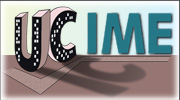




 |
 |
 |
 |
 |
Urban Change - Integrated Modeling Environment
PROJECT SUMMARY
This three-year project will develop an integrated modeling environment (IME) for the cross-disciplinary study of a wide range of questions pertaining to urban change. At the core of IME is a model of evolving urban spatial structure developed by Clarke and already successfully applied to the Baltimore and San Francisco metropolitan areas. This research drastically extends the capabilities of the Clarke model by allowing it to be combined with a variety of other models of natural and social processes affecting the urban realm, by strengthening its theoretical and technical base and analytical utility, and by integrating it within a portable user-friendly modeling environment for the investigation of a variety of urban research and policy questions. IME consists of two levels. At the IME-1 level the focus is on the changing urban spatial structure, as in the original Clarke model, but now a much more versatile and sophisticated range of urban growth models can be built through linkage with models of other natural and human urban subsystems. The IME-2 level is for investigating more general, not directly geographic urban research and policy questions, where urban spatial structure is one of several key factors. The research plan consists of four interrelated tasks. Task One develops the theoretical and technical framework for the IME. Task Two demonstrates and tests the validity of the approach at the IME-1 level through modeling and analyzing the growth patterns of selected metropolitan regions. Task Three demonstrates and tests the validity of the approach at the IME-2 level with a study seeking to predict land use intensity and population distribution through coupling of several different models of physical and human processes, including a model of urban spatial structure. Task Four focuses on the computational implementation and dissemination of the IME. Dissemination plans include the development of two (one undergraduate and one graduate) Web-based courses on urban change at UCSB suitable for emulation elsewhere. The project is linked through subcontracts to two other major federally funded projects: the Urban Retrospectives/Urban Dynamics initiative at the United States Geological Survey will provide the data for the metropolitan areas and assist with the more routine modeling work. The Urban Security initative at the Los Alamos National Laboratory will contribute advanced expertise on the theoretical and technical aspects of complex dynamic models, and on the coupling of physical science models with urban models. It will also provide access to supercomputing resources where needed. The broader contributions of the project are theoretical and empirical and include impacts in terms of human resource development. From a theoretical perspective, the project will lead to advances in the approach to urban theory and modeling. Until now most urban modeling efforts have been scale- and discipline-specific. Our approach is integrative and interdisciplinary and breaks new ground by systematizing the conditions under which diverse model structures may be linked. From an empirical viewpoint, the work will generate new measures for model comparison, analysis and testing, a new use for data collected by others at great effort and cost, a new understanding of the evolution of a number of major urban areas, new visualization methods suitable for both social-science and physical-science oriented urban research, and new types of tools for exploring alternative urban planning and policy scenarios. The project will also contribute to human resource development by providing an environment for scientists from very different disciplines to work together. Our project team includes researchers with backgrounds in human and physical geography, cartography, architecture and planning, chemistry, and physics. We will demonstrate to our peers, and persuade our students, that those investigating the diverse fragments of the same real world can indeed fruitfully work together.
Support for this project is from the National Science Foundation : 
Contact the project Web Master.